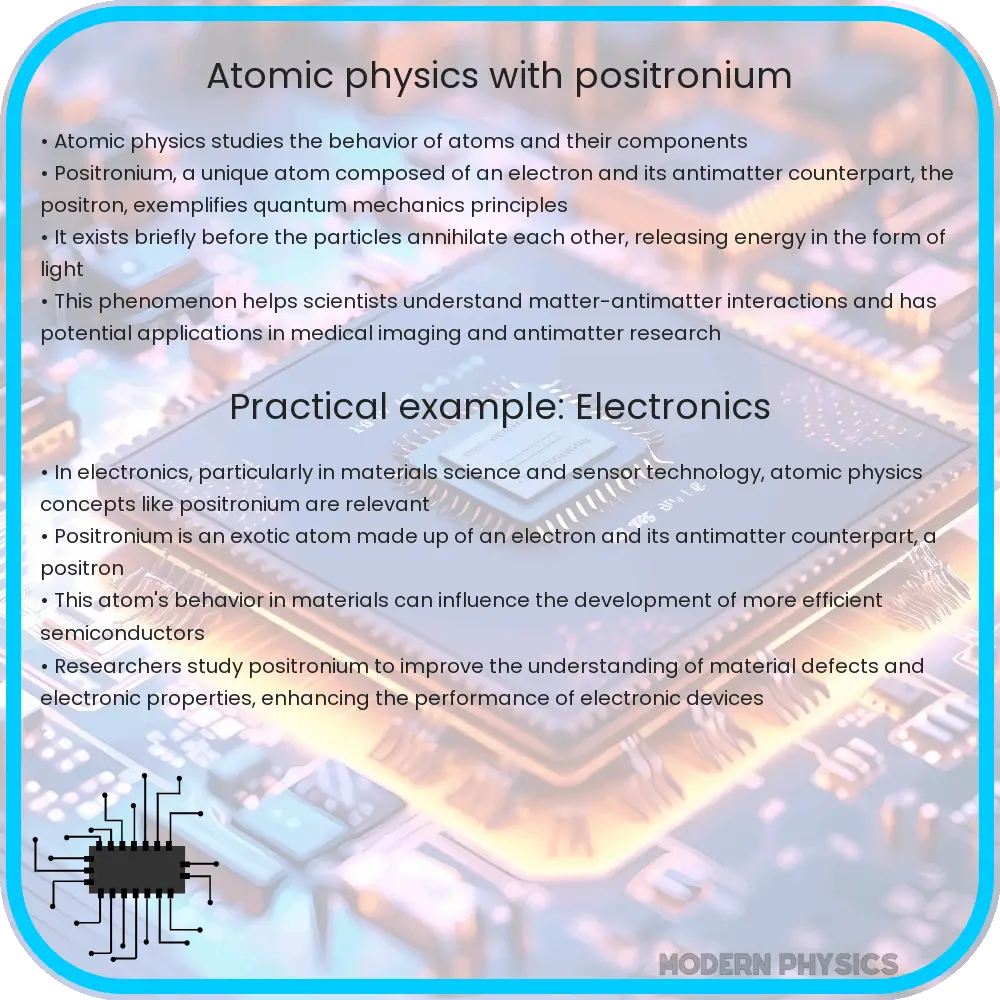Positronium is a quasiparticle composed of an electron and a positron bound together, revealing insights into matter-antimatter interactions and quantum mechanics.

Introduction to Positronium
Positronium is a unique and fascinating quasiparticle that consists of an electron and its antiparticle, the positron, bound together by electromagnetic forces. Discovered theoretically by Carl D. Anderson in 1932 shortly after the discovery of the positron, positronium offers a compelling study of matter-antimatter interactions, shedding light on the principles of quantum mechanics and atomic physics.
Formation of Positronium
Positronium is formed when a free electron and a positron encounter each other and bind together. The formation process can generally occur in two different states:
- Singlet State (Para-Positronium): This state occurs when the spins of the electron and positron are antiparallel, that is, pointing in opposite directions. Para-positronium is denoted as e+e– with a total spin of 0.
- Triplet State (Ortho-Positronium): In this state, the spins of both particles are parallel, pointing in the same direction. Ortho-positronium has a total spin of 1 and is symbolized as e+e–.
These two states are distinguished primarily by their differing lifetimes and decay mechanisms.
Decay of Positronium
Positronium is an unstable entity and undergoes self-annihilation. The lifetime of positronium depends significantly on its state:
- Para-Positronium: Typically, para-positronium decays into two gamma rays with an average lifetime of about 125 picoseconds. The decay can be represented by the equation:
$$ e^+ + e^- \rightarrow 2\gamma $$ - Ortho-Positronium: Ortho-positronium, on the other hand, usually decays into three gamma rays and has a longer lifetime of around 142 nanoseconds. The decay process is given by:
$$ e^+ + e^- \rightarrow 3\gamma $$
The differing numbers of gamma rays in the decay processes are a consequence of conservation laws, including charge, momentum, and angular momentum.
Experimental Significance
The study of positronium is pivotal in testing the fundamentals of quantum electrodynamics (QED). Measurements of its decay rates and lifetimes help physicists test the precision of QED predictions. Additionally, the interactions and decays of positronium provide insights into the properties of vacuum and electromagnetic fields.
Furthermore, positronium has potential applications in materials science, such as positron annihilation lifetime spectroscopy, which is used to study the microstructure of materials. Its sensitivity to changes in electron density makes it an effective probe for detecting voids, defects, or changes in the electronic structure of materials.
Applications in Medical Imaging
Positronium is not only useful in materials science but also has promising implications in the medical field, particularly in positron emission tomography (PET). PET scans, which are critical in diagnosing and monitoring treatments for cancer and other diseases, rely on positrons. The use of positronium could potentially enhance the resolution and effectiveness of PET imaging. Researchers are studying positronium’s interaction with biological tissues to optimize imaging techniques and improve diagnostic accuracy.
Theoretical Implications
The existence and properties of positronium also challenge and expand our understanding of theoretical physics. By studying positronium, researchers can explore the delicate interplays within quantum mechanics and special relativity in a controlled setting. This helps in verifying theoretical predictions and in improving models that describe particle interactions on an atomic level.
Future Prospects
Looking forward, the study of positronium may open new pathways in quantum computing and quantum information science. Due to its unique properties, such as its quantum entanglement capabilities, researchers are investigating whether positronium can be used in quantum logic gates or for other quantum information tasks. These explorations could lead to breakthroughs in computing technology and further our comprehension of quantum mechanics in practical applications.
Conclusion
Positronium, a quasiparticle forming from an electron and its antiparticle, the positron, provides a fascinating glimpse into the fundamental nature of matter and antimatter. Its formation, decay, and potential applications stretch across fields from basic physics to practical technologies like medical imaging and materials science. The ongoing study of positronium not only deepens our understanding of quantum electrodynamics and particle interactions but also propels advancements in various scientific and technological arenas. As research continues, the array of possibilities for utilizing positronium in scientific and technological applications is vast, promising exciting developments in the near future.
